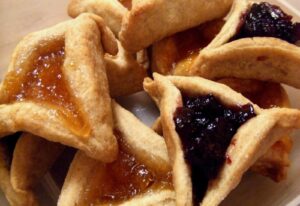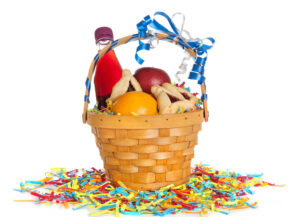Happy Purim 2022
The Heroine
The Food
The Celebration
The festival of Purim commemorates when Esther, the Queen of Persia saved the Jews from extermination by Haman, the advisor to the Persian king. Esther had previously hidden her Jewish identity from her husband and saved the Jews by bravely revealing her identity and informing the king of Haman’s plan to wipe out the Jewish population.

THE CELEBRATION
In modern times, the holiday is known for its celebratory atmosphere that includes the reading of the Megillah (the story of Esther and Haman), costumes and carnivals. The story of Purim includes many elaborate feasts, so it comes as no surprise that there are many symbolic foods related to the holiday as well

One of the most iconic symbols of Purim is hamantaschen which are triangular shaped cookies that are said to represent Haman’s three-cornered hat. Hamentaschen can be filled with fruit, nuts, chocolate, or a more traditional poppy seed paste. It has been said that taking a bite out of a hamentaschen cookie can be seen as an act of defiance of bowing down to Haman and preventing him from carrying out his plan.
Eating triangular shaped foods during Purim is a popular tradition for Ashkenazi Jews which is one of two reasons that Kreplach, triangular dumplings filled with chopped meat, are eaten during this holiday. The second reason is that the filling hidden inside of the dough is symbolic of the secret that Queen Esther kept or that the hidden nature of the kreplach interior represents the hidden nature of the Purim miracle.
Purim is also associated with drinking wine. But why is that? According to Haaretz.com, “The custom of drinking wine on Purim stems from a quotation in the Talmud attributed to a fourth century Rabbi, Rava: ‘One must drink on Purim until that person cannot distinguish between cursing Haman and blessing Mordechai”
SHALACH MANOT – a Purim gift

Lastly, shalach manot is another food-related tradition of Purim. Shalach manot are Purim baskets typically filled with sweets but can include other types of food that are considered “ready to eat”. The mitzvah of giving these baskets derives from the Book of Esther and is meant to ensure that everyone has enough food for the Purim feast typically held later in the day. The Book of Esther instructs that Purim is a time for “feasting and joy and giving presents of food to one another”
There are three different mitzvot mentioned in the Book of Esther: 1) Eating a Purim meal. 2) Sending shalach manot to a friend. 3) Distributing charitable donations to those less fortunate. This Purim as you prepare to fulfill the three mitzvot, please consider giving a monetary gift to Maot Chitim of Greater Chicago to ensure those that need food will have food on their table.
